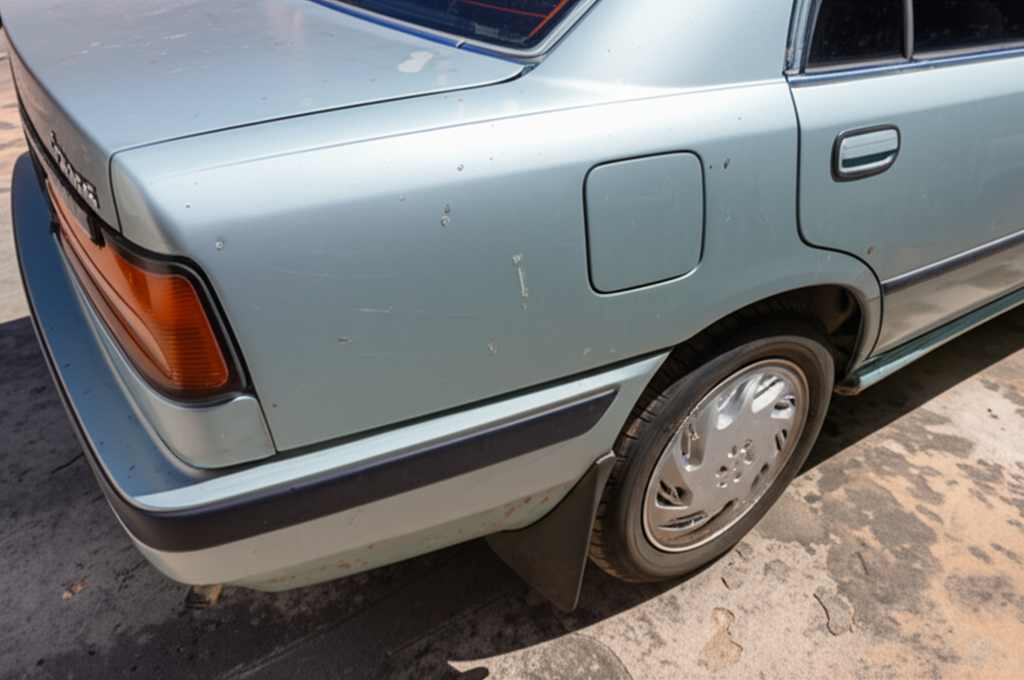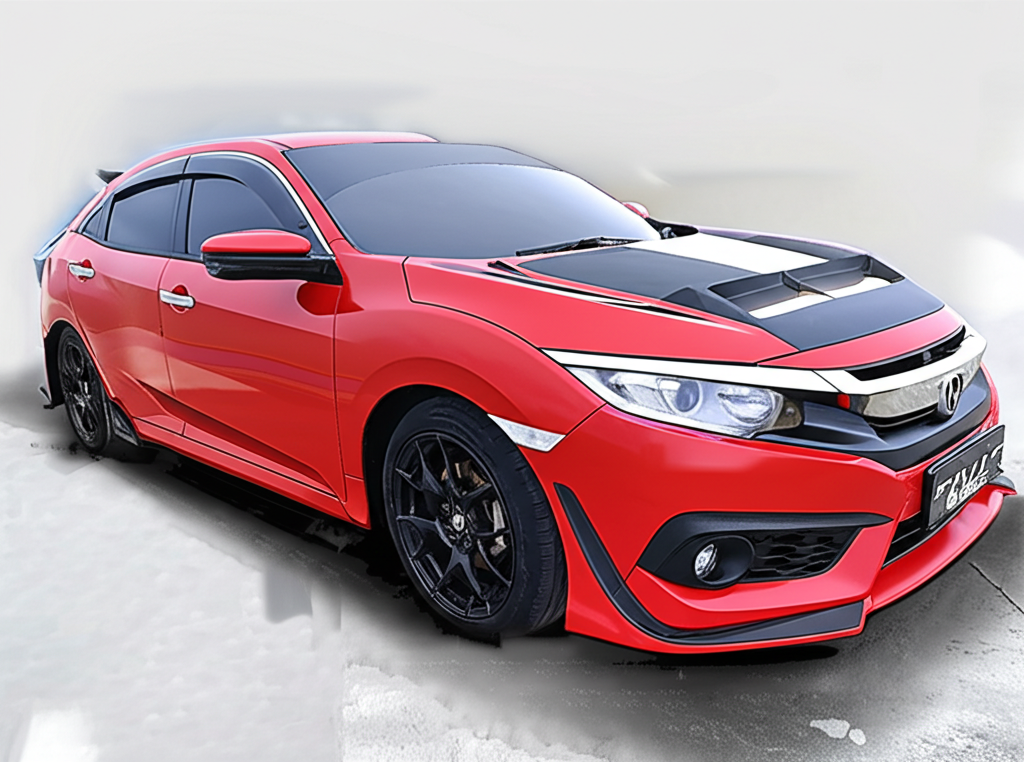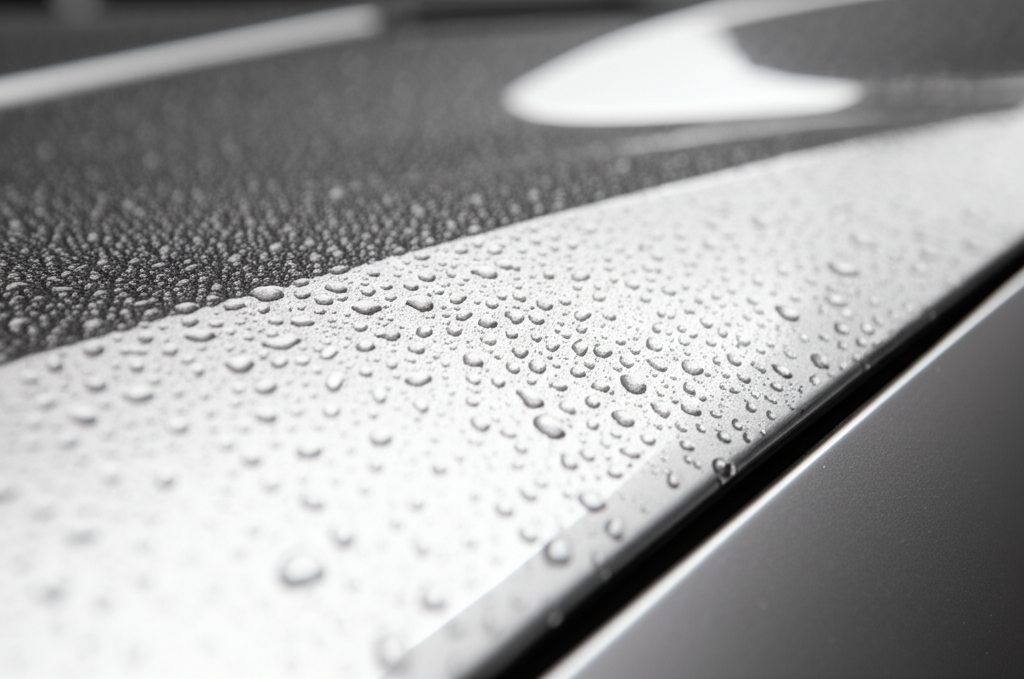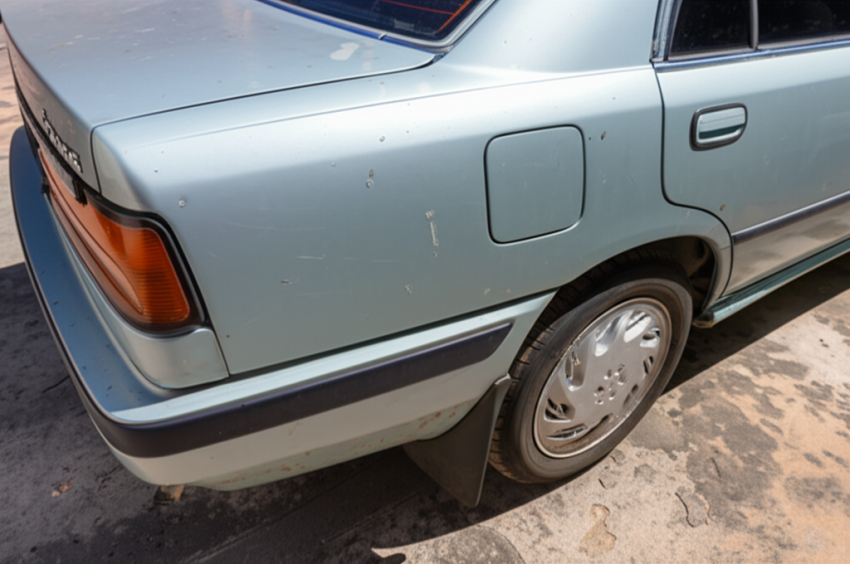Let’s be honest. Owning an older car in Thailand, especially in bustling cities like Bangkok or Chiang Mai, comes with its unique set of challenges for your car’s paintwork. The relentless sun, the sudden downpours, the unavoidable traffic scrapes, and the accumulated minor scratches from daily use can take a heavy toll. If you’re like many long-term car owners, you’ve probably found yourself in a frustrating cycle: you notice the fading paint, the swirl marks, maybe a deeper scratch. You head to the workshop, spend a not-insignificant amount of Baht on polishing, touch-ups, or even partial repaints. It looks good for a while, but inevitably, the elements and daily grind start the process all over again. Are you tired of pouring money into these temporary surface fixes, only to see the shine fade and new imperfections appear? Are you wondering if there’s a more sustainable, long-term way to protect your beloved older car and keep it looking sharp without the constant upkeep? Could a modern solution like TPU paint protection film finally break this expensive cycle?

Meet Somchai: A Decade-Old Civic’s Journey from Dull to Dazzling
Let’s talk about Mr. Somchai, a Bangkok resident and the proud owner of a 2012 Honda Civic. For years, Somchai loved his reliable Civic, but he grew increasingly frustrated with its appearance. Multiple rounds of polishing had thinned the clear coat in places, touch-up paint never perfectly matched the sun-faded original colour, and tiny scratches seemed to multiply overnight thanks to tight parking spots and motorcycle traffic. “Every six months, it felt like I was back at the shop,” Somchai recalls. “Polishing here, a bit of paint there… the cost was adding up, maybe 5,000-10,000 Baht a year, sometimes more if there was a bigger scrape. And honestly, it never looked truly *great* for long.”
He considered a full repaint, but the cost (upwards of 30,000-50,000 Baht for decent quality) felt excessive for a car of its age. Plus, he knew a repaint wouldn’t protect it from future damage. That’s when a friend mentioned TPU (Thermoplastic Polyurethane) paint protection film (PPF). Initially sceptical – wasn’t that just for expensive new supercars? – Somchai did some research. He learned about TPU’s protective qualities, its self-healing properties for minor scratches, and its ability to maintain a high-gloss finish.
Three years ago, Somchai decided to take the plunge. He found a reputable installer in Bangkok specializing in quality TPU films suitable for the Thai climate. The process involved meticulous cleaning and preparation of his Civic’s existing paint (after a final professional polish to get the base as good as possible) followed by the careful application of the transparent TPU film over every painted panel. The initial investment was significant, comparable to a high-quality partial repaint, but Somchai viewed it as a long-term investment.
Fast forward three years. Somchai’s Civic still turns heads. The paint underneath the film remains preserved, protected from UV fading, bird droppings, minor abrasions, and stone chips. Small swirl marks that appeared on the film from washing vanished on hot days thanks to the film’s self-healing properties. Washing the car became remarkably easier due to the film’s hydrophobic surface. “It’s been a game-changer,” Somchai beams. “No more constant worry about minor damage. No more budgetting for polishing every few months. The car looks fantastic, probably better than it has in years. The upfront cost has easily paid for itself in saved maintenance and peace of mind.”

TPU Film vs. Traditional Paint Maintenance: An Honest Comparison
So, what exactly is TPU film, and how does it stack up against the polishing, waxing, and touch-up routines many older car owners are accustomed to? Let’s break it down.
TPU Paint Protection Film (PPF): This is a transparent, durable, and flexible film made from Thermoplastic Polyurethane. It’s applied directly over your car’s existing paintwork. High-quality TPU films offer several key advantages:
- Superior Protection: Acts as a physical barrier against stone chips, minor scratches, bug splatter, bird droppings, tree sap, and harmful UV rays that cause paint to fade.
- Self-Healing Properties: Many premium TPU films can self-heal minor scratches and swirl marks when exposed to heat (like the sun or warm water).
- Enhanced Appearance: Provides a high-gloss finish (or satin/matte options) that can rejuvenate the look of older paint.
- Hydrophobic Qualities: Repels water and dirt, making the car easier to clean and stay clean longer.
- Longevity: Quality films installed professionally can last anywhere from 5 to 10 years, even in harsh climates like Thailand’s, often coming with warranties.
- Reversibility: Can be removed professionally without damaging the underlying factory paint, preserving the car’s original finish (crucial for resale value).
Traditional Paint Maintenance: This typically involves:
- Washing: Essential, but frequent improper washing can cause swirl marks.
- Waxing/Sealants: Provide temporary protection (weeks to months) and enhance gloss, but offer minimal defence against physical damage like scratches or stone chips. Needs frequent reapplication.
- Polishing: Removes a fine layer of the clear coat to eliminate minor scratches and oxidation. Effective, but can only be done a limited number of times before the clear coat becomes too thin. Doesn’t prevent future damage.
- Touch-ups/Repainting: Addresses deeper scratches or widespread fading. Can be costly, time-consuming, and achieving a perfect colour match on older, faded paint can be difficult. Does not add future protection.
Here’s a comparison table to highlight the key differences:
| Feature | TPU Paint Protection Film | Traditional Maintenance (Waxing, Polishing, Touch-ups) |
|---|---|---|
| Protection Level | High (Physical barrier against chips, scratches, stains, UV) | Low to Moderate (Minimal physical protection, temporary UV/contaminant resistance) |
| Durability / Longevity | Very High (5-10 years for quality films) | Low (Wax/sealants last weeks/months; Polishing removes paint; Touch-ups don’t prevent recurrence) |
| Self-Healing | Yes (for minor scratches/swirls on premium films) | No |
| Initial Cost | High | Low (for basic wax/polish) to Moderate/High (for professional detailing/touch-ups/repairs) |
| Long-Term Cost | Potentially Lower (Reduces need for frequent polishing, touch-ups, or repainting) | Can be High (Cumulative cost of repeated treatments and repairs) |
| Maintenance Effort | Low (Easier washing, no need for waxing/polishing the film) | Moderate to High (Requires regular washing, waxing/sealing, periodic polishing) |
| Appearance Enhancement | High (Restores gloss, provides uniform finish, can offer matte/satin options) | Variable (Polishing/waxing enhances gloss temporarily; Touch-ups can be visible) |
| Reversibility | Yes (Professionally removable, preserving original paint) | Partially (Polishing removes paint permanently; Repainting changes original finish) |
| Best Suited For | Owners seeking long-term protection, appearance preservation, reduced maintenance, especially for cars exposed to harsh conditions or frequent use. Ideal for preserving decent existing paint. | Owners on a tighter initial budget, those who enjoy frequent detailing, or cars with paint already in poor condition needing restorative work first. |
Voices from the Road: Thai Car Owners on TPU Film
Mr. Somchai isn’t alone. Many older car owners in Thailand are discovering the benefits of TPU film:
“My Toyota Vios is nearly 8 years old. I live near the coast in Pattaya, and the salty air plus sun was brutal on the paint. I got a TPU wrap two years ago. Before, I was constantly battling dullness and tiny rust spots starting. Now? It looks glossy, washing is a breeze, and I haven’t spent a single Baht on polishing since. The initial worry about cost disappeared seeing how well it protects.”
– Niran, Chonburi (Emotional Shift: Constant Worry -> Relaxed Confidence)
“I use my Mitsubishi Triton for work and family trips – it sees highways, city traffic, and occasional rough roads. Minor scratches were unavoidable. Polishing helped, but it felt like fighting a losing battle. The TPU film was an investment, but knowing the original paint is safe underneath gives me incredible peace of mind. A rogue shopping cart hit my door – marked the film, but the paint was perfect! Saved me a costly repair.”
– Anchalee, Nakhon Ratchasima (Emotional Shift: Resignation -> Secure Peace of Mind)
“Honestly, I was embarrassed by how faded my old Mazda 2 looked. A repaint seemed too much. The TPU wrap not only protects it but made it look almost new again. Friends were asking if I bought a new car! It completely changed how I feel driving it.”
– David, Chiang Mai (Emotional Shift: Embarrassment -> Renewed Pride)
Ready to Break the Cycle?
If you’re an owner of an older car in Thailand, tired of the endless cycle of polishing, touching up, and worrying about paint damage, TPU paint protection film offers a compelling alternative. It’s not just about making your car look good temporarily; it’s about investing in long-term preservation, protection, and peace of mind. Stop throwing money at surface-level fixes that don’t last. Explore how a quality TPU wrap can safeguard your car’s paintwork for years to come, maintain its appearance, and potentially save you money and hassle in the long run.
Want to learn more about TPU options for your specific car model and get a personalized quote? Reach out to our experts today.
📱 Want to learn more about car wrap & paint protection?
Feel free to reach us on LINE:

🌐 Official Website: https://tpuwraps.com
Frequently Asked Questions (FAQ)
- Q: Is TPU film very expensive compared to traditional methods?
- A: The initial cost of a full TPU wrap is significantly higher than a single session of waxing or polishing, and can be comparable to a quality partial repaint. However, considering it lasts 5-10 years and drastically reduces or eliminates the need for frequent polishing, touch-ups, and potentially repainting sections due to damage, the long-term cost can be very competitive or even lower. Think of it as pre-paying for years of paint maintenance and protection.
- Q: Can TPU film be applied to a car with existing paint damage or previous repaint work?
- A: For best results, the underlying paint should be in good condition. Minor swirl marks or light fading can often be corrected by professional polishing before application. However, deep scratches, chips down to the metal, rust, or poorly executed previous repaint work should ideally be professionally repaired *before* wrapping. Applying film over damaged paint might make the imperfections more noticeable or could lead to issues during removal (e.g., pulling loose paint). It’s crucial to have the installer assess your car’s specific condition.
- Q: How durable is TPU film in Thailand’s hot and humid climate?
- A: Quality TPU films from reputable brands are specifically designed to withstand harsh environmental conditions, including strong UV exposure and high humidity. Look for films with good UV inhibitors and stable adhesives. With proper installation and basic care, premium films typically last 5-10 years in Thailand, often backed by manufacturer warranties against yellowing, cracking, or peeling.
- Q: Does TPU film require special maintenance?
- A: Maintenance is generally easier than caring for unprotected paint. Regular hand washing with a pH-neutral car soap and a soft wash mitt is recommended. Avoid abrasive brushes or harsh chemicals. Many films are hydrophobic, meaning water and dirt slide off easily. You don’t need to wax or polish the film itself; some manufacturers offer specific sealants designed for PPF to enhance its properties, but it’s often optional.
- Q: Will removing the TPU film damage my car’s original paint?
- A: When a quality TPU film is removed professionally and within its expected lifespan, it should not damage healthy, factory-applied OEM paint. The adhesive is designed to release cleanly. However, issues can arise if the underlying paint was already weak, damaged, or if it’s a poor-quality aftermarket repaint. This is why choosing a reputable installer who uses quality film is vital, especially for older vehicles.
Invest in Preservation, Not Just Polishing
For older car owners in Thailand facing the constant battle of maintaining their vehicle’s appearance against the elements and daily wear, TPU paint protection film presents a powerful solution. It moves beyond the temporary fixes of traditional methods, offering a robust shield that preserves your car’s paintwork, enhances its look, and simplifies maintenance for years. While the initial investment requires consideration, the long-term savings in cost, time, and stress, coupled with the pride of driving a well-protected and sharp-looking car, make it a compelling choice.
Don’t let your car’s paint fade away under the Thai sun or succumb to the scratches of city life. Consider the lasting benefits of TPU film – it might just be the smartest investment you make in preserving your automotive companion.

